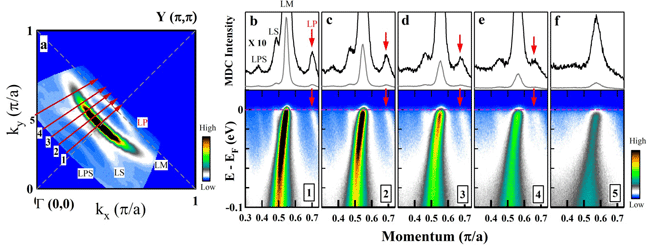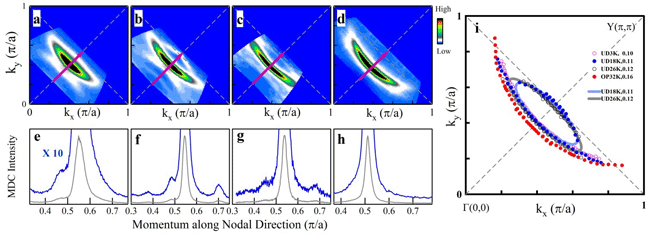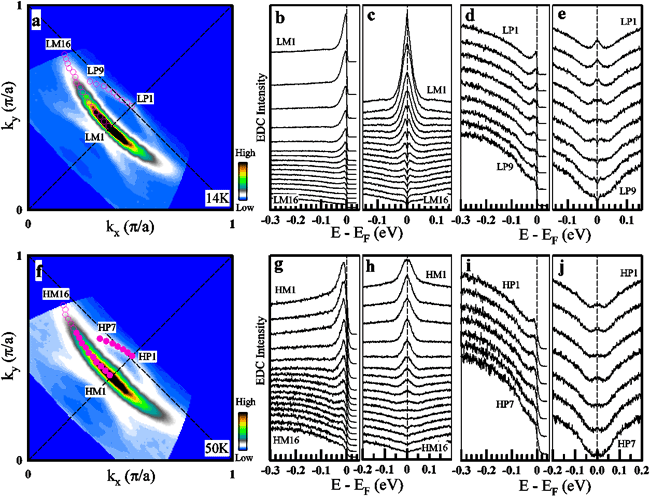Direct Observation of Fermi Pockets and their Coexistence with Fermi Arcs in High-Tc Copper-Oxide Superconductors
Date:15-12-2009 Print
The discovery of high temperature copper-oxide (cuprate) superconductors in 1986 has posed many fundamental challenges in condensed matter physics. The parent compound of cuprate superconductors is an antiferromagnetic insulator; it becomes metallic and superconducting by doping charge carriers (electrons or holes). It is found that in the so-called underdoped region where only a small amount of carriers are introduced, cuprate superconductors exhibit a number of anomalous normal state properties (above superconducting transition temperature, Tc), which deviate significantly from the conventional theory of metals -- the Landau Fermi liquid theory. The most unusual phenomenon in the underdoped regime is the existence of so-called “pseudogap”. In the conventional superconductors, superconducting gap (the energy cost for breaking Cooper pairs) opens only below Tc. However, in the underdoped region of cuprates, an energy gap already opens above Tc even though the material is not superconducting yet. Understanding the anomalous properties of the underdoped cuprates, particularly the nature of pseudogap and its relation with superconductivity, is critical in unraveling the mechanism of high-Tc superconductivity.
What is the Fermi surface topology in the underdoped region of cuprate superconductors? This is a basic yet very critical question in order to understand the anomalous physical properties. However, the answer has been controversial, both theoretically and experimentally, in the past two decades, Theoretically, different Fermi surface topologies are predicted including large Fermi surface, disconnected Fermi arc and Fermi pocket. Experimentally, results from various techniques provide different pictures. Recent quantum oscillation experiments suggest the possible existence of Fermi pockets in underdoped samples. However, results from the angle-resolved photoemission spectroscopy (APRES), a powerful technique capable of directly measuring Fermi surface, favors the Fermi arc picture.
Prof. X.J. Zhou’s group at the Institute of Physics, Chinese Academy of Sciences, has made important progress in studying the electronic structure of high-Tc cuprate superconductors by using ultra-high-resolution vacuum ultraviolet (VUV) laser-based ARPES. They observed the existence of Fermi pocket directly and its coexistence with Fermi arc. This result is published in Nature on Nov. 19, 2009 [Jianqiao Meng et al., Nature 462(2009)335] and has attracted a lot of attention in the superconductivity community.
 |
| Fig. 1. Fermi surface (Fig.1a) and band structure (Fig.1b-f) of underdoped Bi2(Sr2-xLax)CuO6(x=0.73, Tc=18K) obtained by laser ARPES. In Fig.1a, main Fermi surface LM and Fermi surface sheet LP form an enclosed loop –a Fermi pocket. |
Fig.1 shows the Fermi surface and band structure of underdoped Bi2201 sample obtained by a VUV laser-based ARPES. Three Fermi surface sheets with low spectral weight were revealed in addition to the prominent main Fermi surface LM. The Fermi surface sheet LP crosses the main Fermi surface LM, forming an enclosed loop - a Fermi pocket. The spectral weight of LP is less than 1/20 of that of main Fermi surface LM. Therefore, the high resolution and high data quality of VUV laser-based APRES play an important role in identifying the Fermi pocket.
 |
| Fig.2 Doping evolution of Fermi surface topology in Bi2(Sr2-xLax)CuO6samples: (a). x=0.84, Tc=3K; (b). x=0.73, Tc=18K; (c). x=0.60, Tc=26K; (d). x=0.40, Tc=32K. Fermi pocket is observed in Tc=18K(b) and 26K(c) samples. However, it is not seen in the heavily underdoped Tc=3K(a) and optimally-doped Tc=32K(d) samples. |
The Fermi pocket exhibits an unusual doping dependence. Fig.2 shows the Fermi surface mapping for Bi2201 samples with four different doping levels. The former three are underdoped with Tc of 3K (Fig.2a), 18K (Fig.2b) and 26K (Fig. 2c), respectively while the fourth is optimally-doped with a Tc of 32K (Fig.2d). The Fermi pocket is observed in a limited doping range in the underdoped region (Fig. 2b and 2c). But it is not seen in heavily underdoped sample (Fig.2a) or optimally-doped sample (Fig. 2d) .
 |
| Fig.3 The coexistence of Fermi pocket and Fermi arc in Bi2201 sample(Tc=18K). Fig. 3a shows the Fermi surface in superconducting state. Fig. 3b and 3d are photoemission spectra along the main Fermi surface LM and the Fermi pocket LP, respectively. Fig. 3f shows the Fermi surface in the normal state and the corresponding photoemission spectra are shown in Fig. 3g-j. |
One peculiar characteristic of the Fermi pocket is its coexistence with the large underlying Fermi surface. Fig. 3 shows the Fermi surface and its corresponding photoemission spectra above (Fig. 3, top panels) and below (Fig. 3, bottom panels) Tc, from which the energy gaps can be deduced. Below Tc, as shown in Fig.3c and 3e, an anisotropic superconducting gap opens on both the main Fermi surface LM and the Fermi pocket LP. Above Tc, as shown in Fig. 3h and 3j, the Fermi pocket LP becomes gapless. However, only a portion of the main Fermi surface LM near the nodal region becomes gapless while gap remains near the anti-nodal region. The pink solid circles in Fig. 3f represent the gapless region on the Fermi pocket LP and the main Fermi surface LM. The gapless section on the main Fermi surface LM appears to extend farther than the Fermi pocket section LP. This gives rise to an interesting coexistence of Fermi pocket (enclosed Fermi surface loop formed by gapless LP and gapless LM portion) and Fermi arc (gapless region on the main Fermi surface LM).
The observed Fermi pocket is hole-like, and the area it enclosed is related to the doping level (Fig. 2i). These results, combined with the Fermi pocket location in Brillouin zone (Fig. 2i) and its peculiar doping dependence (Fig. 2), provide important information in pinning down the Fermi surface topology in the underdoped region and examining various theoretical scenarios. Among various theories of Fermi pocket formation. a phenomenological theory based on P. W. Anderson’s resonant valence bond picture captures some main features of the experimental observation, but still with discrepancies. The coexistence of Fermi arcs and Fermi pockets in the normal state has not been expected theoretically so far. Therefore, these findings will provide key insights in developing theories to understand high-Tc cuprate superconductors.
This work is supported by Chinese Academy of Sciences, National Science Foundation of China and the Ministry of Science and Technology of China.

